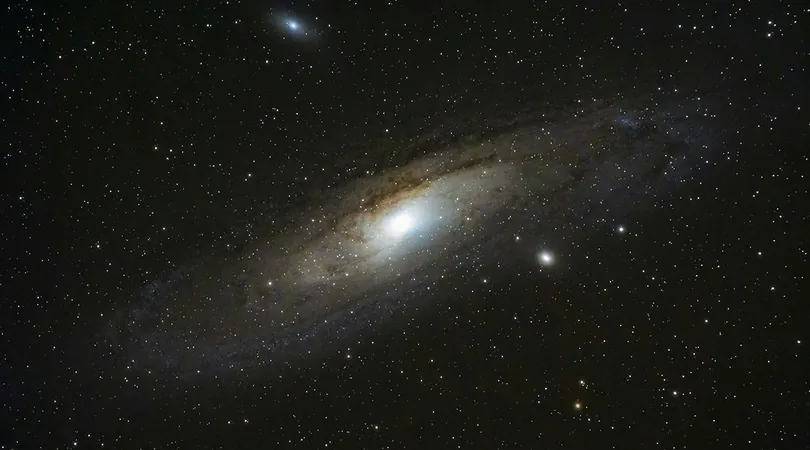
New Insights into Magnetars: Are Fast Radio Bursts the Key to Unraveling Their Origins?
2024-11-13
Author: Wei Ling
The Connection Between Fast Radio Bursts and Magnetars
A major breakthrough occurred in 2020 when the magnetar SGR 1935+2154 in our galaxy was observed emitting a fast radio burst. This rare phenomenon reinforced the hypothesis that there is a significant relationship between FRBs and magnetars.
Multiple theories have emerged explaining how these bursts are generated, with one compelling explanation being starquakes—sudden shifts in a magnetar's crust that release colossal amounts of energy in the form of fast radio bursts. However, crucial questions about the origins of magnetars and their extreme magnetic fields have lingered.
In a recent study, Sharma and her team analyzed data provided by the Deep Synoptic Array (DSA-110), a state-of-the-art radio telescope located at Owens Valley Radio Observatory in California. By studying 30 fast radio bursts, the research team gained vital insights into their origins and characteristics.
“DSA-110 has more than doubled the number of fast radio bursts with known host galaxies,” mentioned Vikram Ravi, an assistant professor of astronomy at Caltech and co-author of the study. “This is precisely what we built the array to achieve.”
This innovative array comprises 110 radio dishes, each measuring 4.65 meters across, and continuously scans the skies for signals at a frequency of around 1,500 MHz. In examining the galaxies from which these fast radio bursts emanated, researchers noticed a striking trend: almost all of these bursts came from large galaxies.
This observation hints that magnetars, unlike typical neutron stars which can form in both large and small galaxies, may predominantly arise in massive galaxies. This offers a more detailed understanding of the specific environments necessary for magnetar formation.
The Role of Metallic Stars
Large galaxies frequently experience numerous cycles of star formation, where lighter elements like hydrogen and helium fuse to form heavier elements, known in astrophysics as "metals." Stars that develop in these metal-rich environments exhibit certain characteristics; they become “metallic,” absorbing more light and altering their physical structure.
This increased metallicity can influence the transfer of material between stars in binary systems. Eventually, this material exchange can lead to stellar mergers. When such mergers occur, the resulting stellar mass can develop an incredibly strong magnetic field via the dynamo effect — where turbulent material's rotational energy is converted into a powerful magnetic field.
“A star with more metal content puffs up, drives mass transfer, culminating in a merger, thus forming an even more massive star with a total magnetic field greater than what the individual star would have had,” Sharma explained.
These theories not only align with current observations but also propose that fast radio bursts predominantly originate in high-metallicity, massive galaxies, lending credence to the idea of magnetars forming from massive star mergers.
Further investigations, however, will be essential to confirm these findings. The ongoing observations from DSA-110 forge a promising link, but a more advanced version — the DSA-2000, currently under construction — aims to provide even more precise data. Featuring 2,000 individual dishes measuring 5 meters across, the DSA-2000 will enhance mapping of fast radio burst sources, potentially clarifying remaining questions about the origins of magnetars.
“This achievement is a milestone for the entire DSA team. Many authors of this paper contributed to the construction of DSA-110, and the array’s precision in localizing fast radio bursts bodes well for the success of DSA-2000,” Ravi concluded.
As researchers delve deeper into the nature of magnetars through the lens of fast radio bursts, the cosmos continues to reveal its secrets — and the saga of these stellar enigmas is far from over.




 Brasil (PT)
Brasil (PT)
 Canada (EN)
Canada (EN)
 Chile (ES)
Chile (ES)
 España (ES)
España (ES)
 France (FR)
France (FR)
 Hong Kong (EN)
Hong Kong (EN)
 Italia (IT)
Italia (IT)
 日本 (JA)
日本 (JA)
 Magyarország (HU)
Magyarország (HU)
 Norge (NO)
Norge (NO)
 Polska (PL)
Polska (PL)
 Schweiz (DE)
Schweiz (DE)
 Singapore (EN)
Singapore (EN)
 Sverige (SV)
Sverige (SV)
 Suomi (FI)
Suomi (FI)
 Türkiye (TR)
Türkiye (TR)